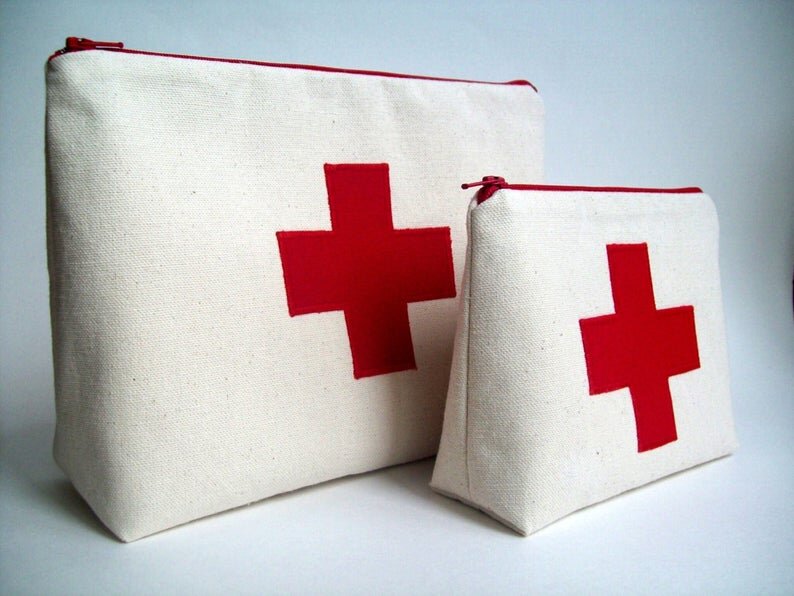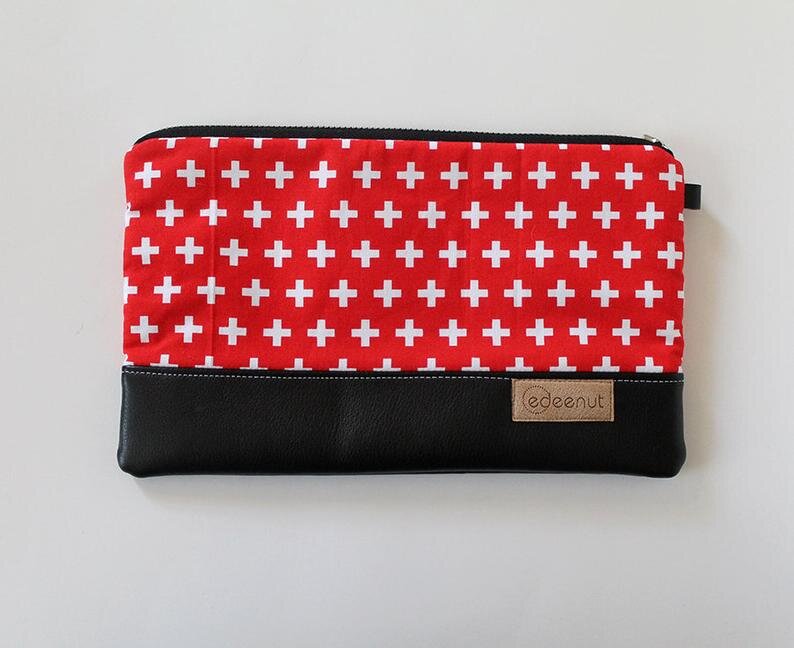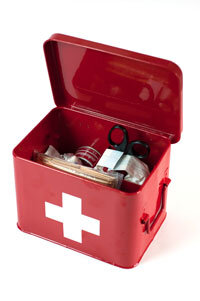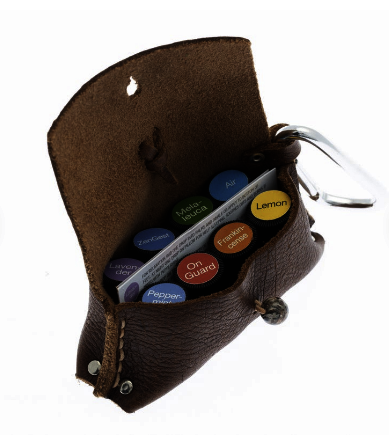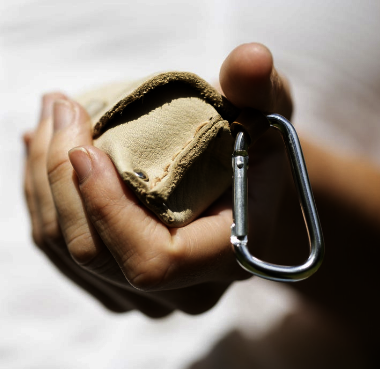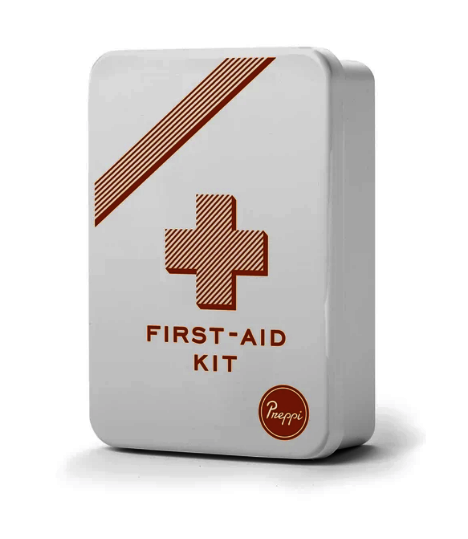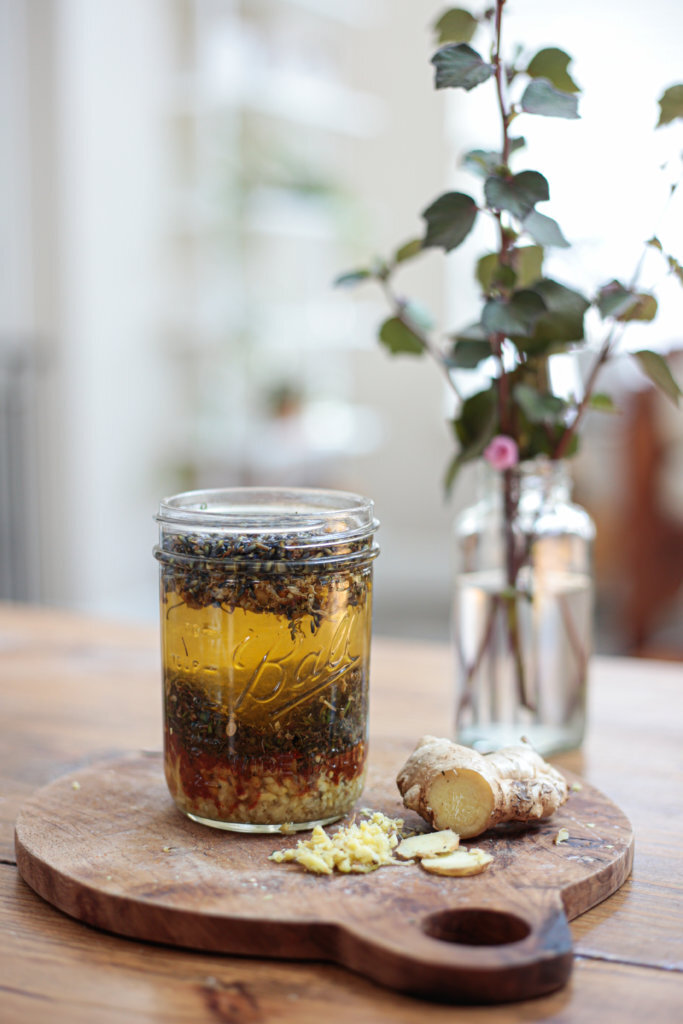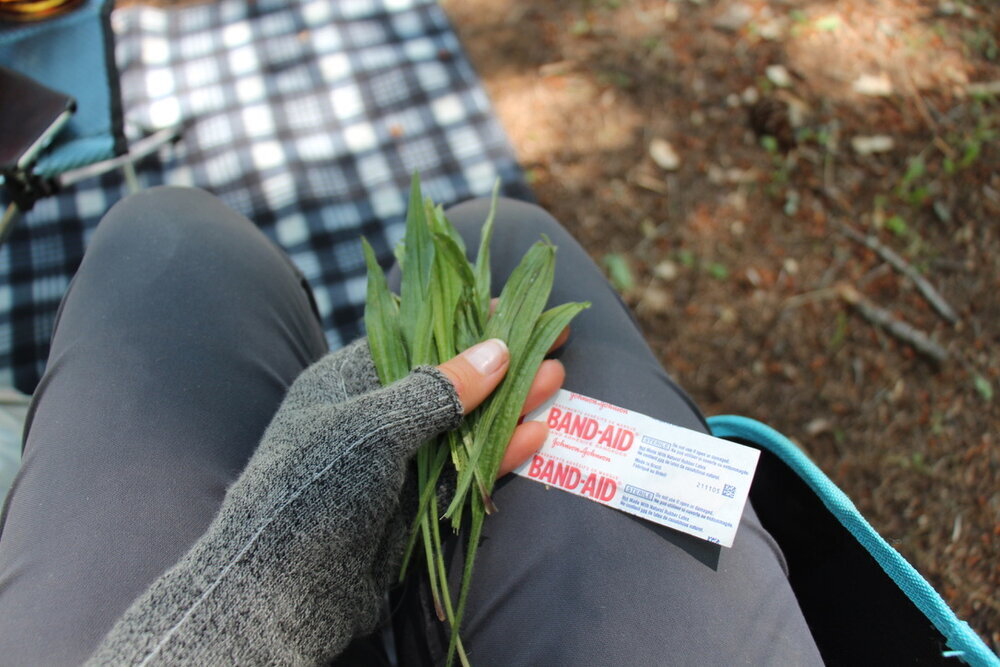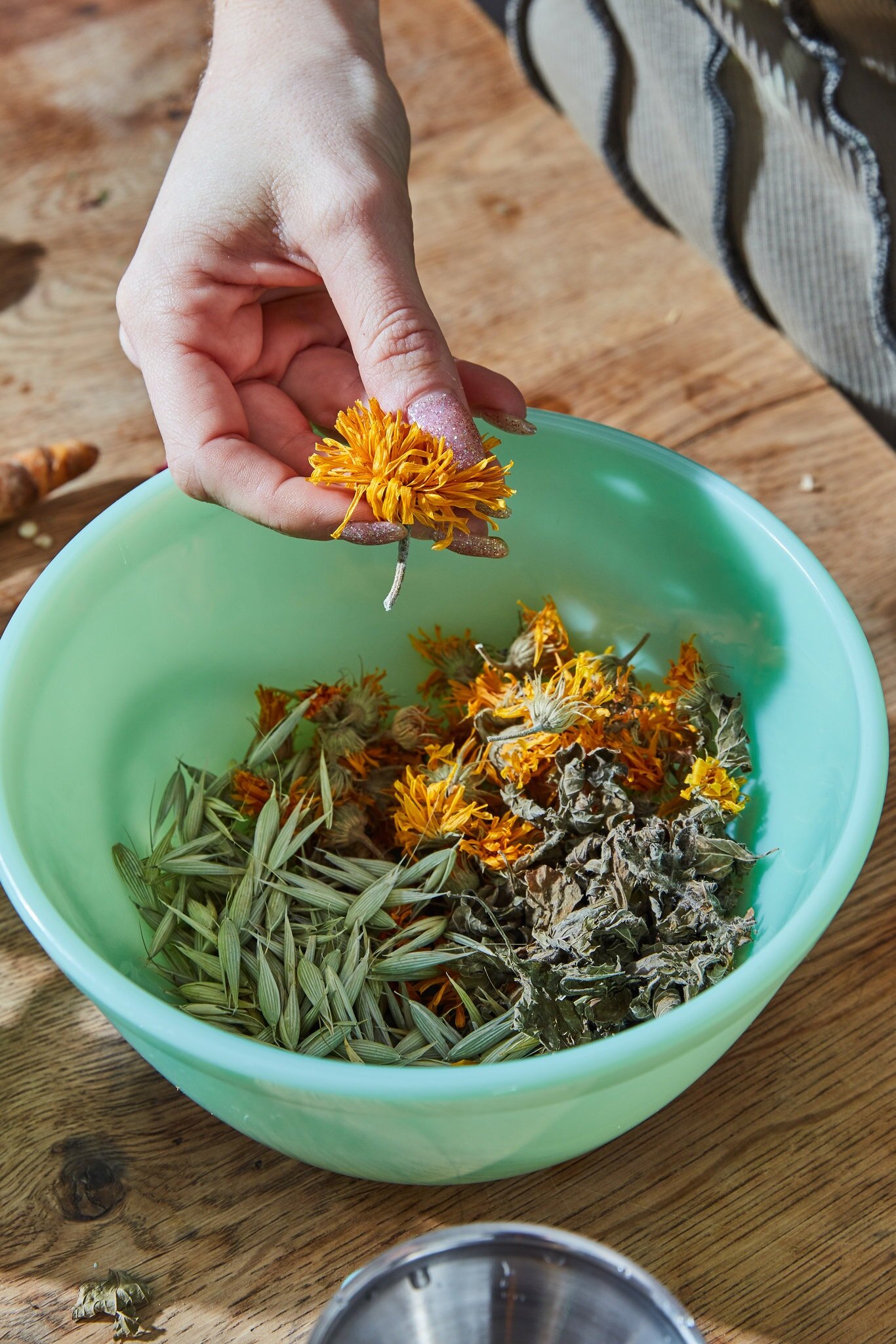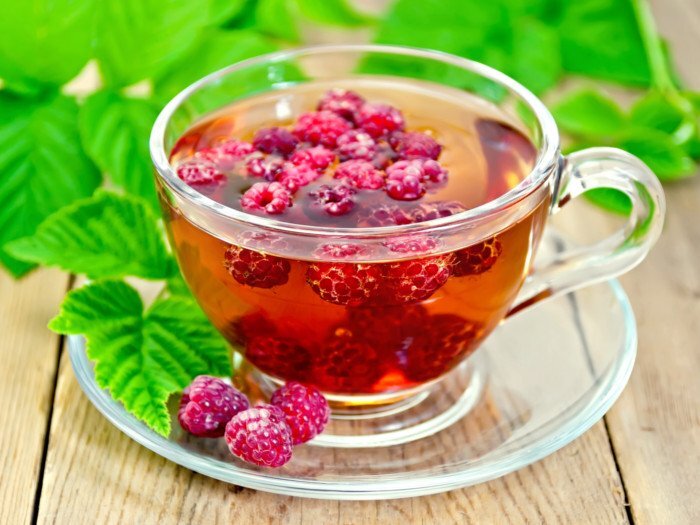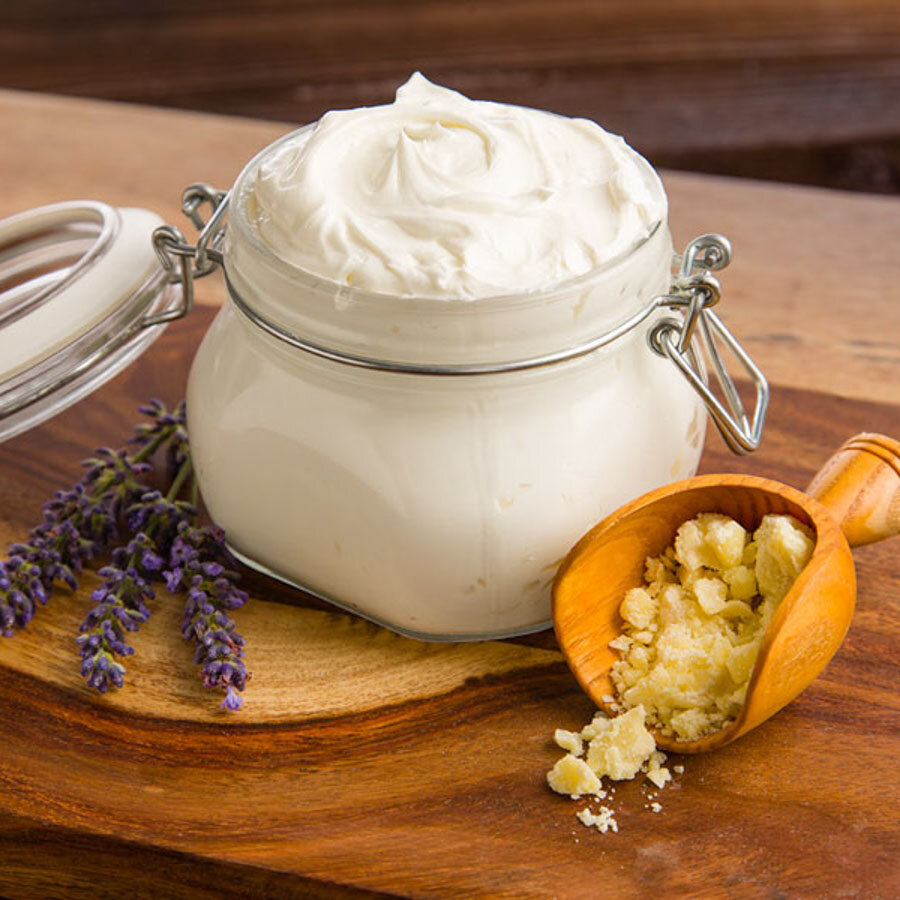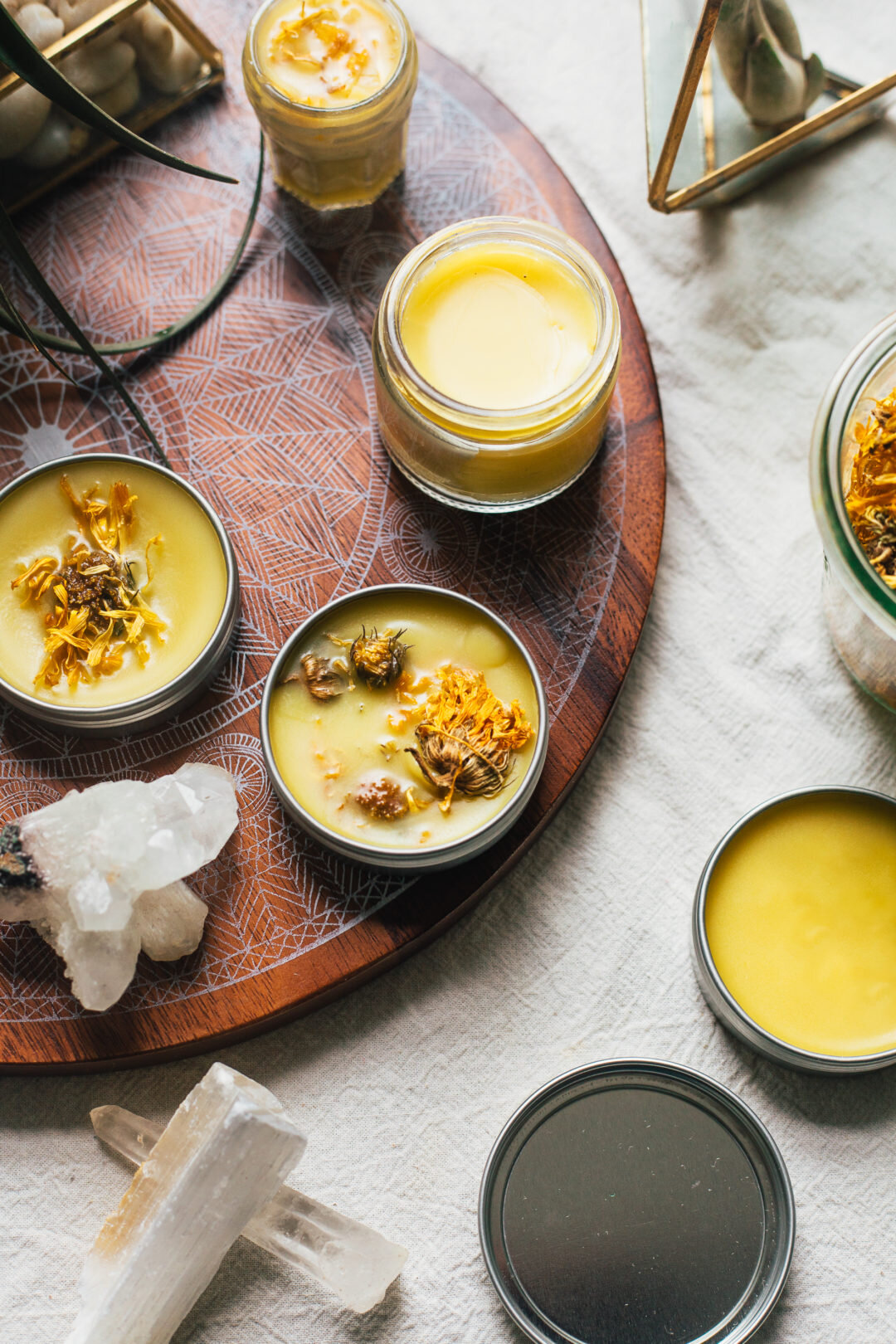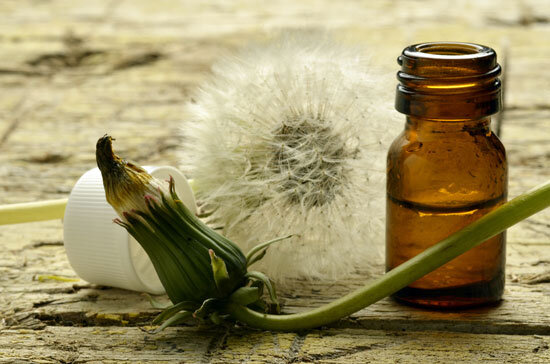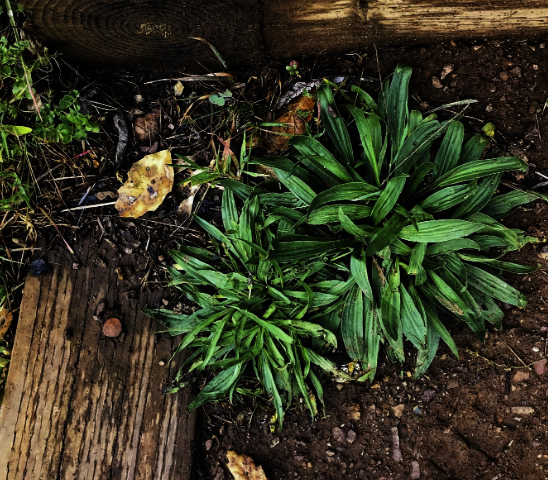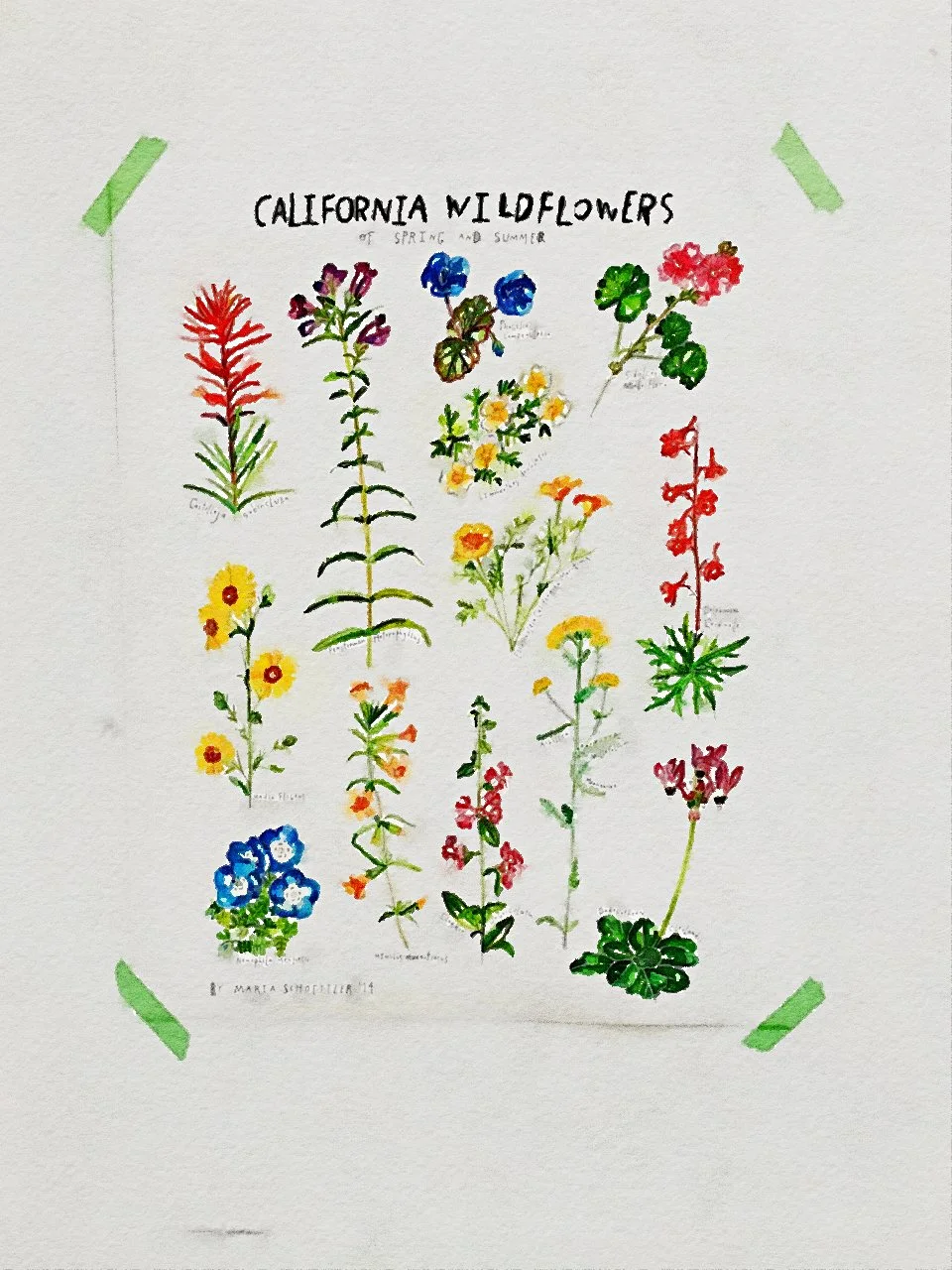Herbal First Aid Kit
Making Your Own First Aid Kit
2x Liniments (a liquid or lotion, especially one made with oil, for rubbing on the body to relieve pain)
Kloss’ Liniment (external use only)
cuts, scratches, skin infections, poison oak (no oils here, makes infection spread!)
Goldenseal, myrrh, (cayenne or echinacea)
soaked in rubbing alcohol* for 6-8 weeks
(*can omit the alcohol and turn into a salve)
St John’s Wort Liniment:
used for both nerve and muscle pain, even sprains.
best from fresh flower (blooms June/July, on the hottest day of the year)
Soak in rubbing alcohol or witch hazel to easily and quickly absorb into the skin
Wound liniment (topical):
Cayenne, Chaparral, Echinacea, Goldenseal, Propolis, Witch hazel
5x powdered herbs, (1oz each or less):
Golden Seal, Myrrh, Cayenne, Echinacea, Slippery Elm
Golden Seal: for infections, one of strongest we have! But it is endangered due to pharma exhausting it. Find sustainably harvested vs wildcrafted.
Myrrh: for blood circulation problems, arthritis, swelling, pain, infection and skin sores, kills bacteria
Combines well with Frankincense
Cayenne: Stops bleeding, excellent for circulation, keeps bowels moving
Echinacea
Slippery Elm
Activated charcoal: adsorbs (not a typo) a lot of toxins
4x EO’s: Lavender, Eucalyptus, Tea Tree, Peppermint
Lavender: for headaches (rub drop on temples/neck), burns/bee or insect bites (apply directly to spot to reduce inflammation), to calm/relax (few drops in a spritzer bottle)
sleep (place a drop on a pillow for sleep)
Eucalyptus EO: bug repellant
Tea Tree Oil: disinfectant, insect bites, stings, toothache.
Peppermint/ginger: for motion sickness
4x Salves (melt carrier oil with distilled herbs)
Choose oil: coconut, cacao butter, olive oil or beeswax. (vitamin E is often added to these as a preservative)
Burns/Scratches/Wounds Salve
St johns wort, calendula flowers, chickweed, comfrey, arnica, valerian, yarrow (equal parts)
V-E (10k IU per cup), and 1/8 part aloe
Bruise Salve
Arnica, Calendula, St. John’s wort, Yarrow
Sore, Inflamed Muscles and joints (more of an oil):
Mullein leaves, hops, lobelia (not for Preggos!), and wintergreen (equal parts)
Per 1 cup oil, add 1-3 tsp. camphor, 1-2 drops wintergreen oil
Antiseptic healing salve
Equal parts: black walnut leaves, Echinacea root, eucalyptus leaves, calendula, golden seal root powder
Wintergreen EO
Healing salve:
Calendula, Chickweed, Comfrey, St. John’s wort
Trauma oil
Arnica, St. John’s wort, Tea tree oil, Valerian, Wintergreen EO
1x Flower essences:
Rescue remedy
Calms nerves and helps with stress, trauma
Star of Bethlehem, rock rose, impatiens, cherry plum, clematis
2x Tinctures:
Sleep, anxiety, pain relief
Valerian, Skullcap
Jet lag
Hawthorn, Gingko
Take ½ to 1 dropper 3x a day, 2 days before through 1-2 days after flight
Pain relief tincture
Hops, Jamaican dogwood, Skullcap, Valerian
Antiseptic tincture (topical use)
Chaparral, Echinacea, Oregon graperoot, Propolis (bee pollen), Witch hazel
Trauma tincture
Damiana, Lavender, Lemon balm, Skullcap, St. John’s wort
Tablets
Arnica: for trauma to tissue, bruises, jagged wounds, torn ligaments, muscles (works great on its own, in liniments)
You’ll be surprised how many little knicks, bites, and stings you’ll get before you finally decide you should make one of these yourself. On our last road trip, we went through an entire package of bandaids, and that’s just between two full grown adults!
While it is one thing to be prepared for these kinds of things, it is also incredibly exciting to learn to find healing plants in the wild. The best part about this is the most nutrient dense plants are those tenacious ones that keep coming back as weeds!
Before getting too lost in the weeds ;) let’s get stuff ready to make our own potent medicine.
There are all kinds of pre made kits out there, which are great- way better than nothing. But my Herbal school (thanks CSHS), just had us make our own, including lots of little tips and tricks to help healing, moving, and to be ready for anything. Plus it can be fun picking out all the little packages today, even making these as awesome gifts! Nothing can be better than homemade medicine made w love. :)
I’ve listed a bunch of helpful recipes to pick from, then picked out my top favorites that are perfect for a little grab bag to go in your car, purse, or suitcase. But everyone’s kit will look a bit different, and that’s kinda the beauty of it. You can have one larger set in your home (plus mother tinctures), and small sets in your to go back. Most of these salves/liniments last years or even decades, and lots of families say they go through a pint of the Kloss’ lineament in a year.
Just remember, anything w rubbing alcohol you may want to dilute w water, esp if using on children, & have a little cloth or something to apply to skin. There’s also magic in the placebo effect to healing, so work that magic, momma! But also be prepared w stuff that’s worked for women for centuries.
Inspiration:
Etsy’s handheld leather essential oil pouch, or 5ml size, $54
Swiss cross pouch, $45
Lined medicine pouch, 3 sizes, $22 +/-
Make your own calendula salve instructions
I couldn’t help but include this cute cross stitch pattern
Make your own mini Altoids Tin can kit with some red/white duct tape
What to do with herbs:
There is a lot to be learned about the details of plant medicines, much more than can be said here. Many herbs are most potent fresh (St. John’s wort and plantain are great examples), while others are best used after being soaked in an alcohol of some sort to pull out its properties (which also preserves it for years, if not indefinitely!). Below are high level recipes of the different kinds of plant medicines you can use.
Liniments: Pour alcohol over herbs, let sit 6-8 weeks or so, pending recipe and herb. apply directly to skin, may need dilution pending alcohol chosen
Tinctures: Alcohol, vinegar or glycerine used to extract herbs and distribute quickly through the bloodstream, taken as a few drops or dropperful by mouth. To make, herbs sit in glass jar with solvent for 6-8 weeks, shaken daily, then strained. Pending solution and herbs, they can last years to whole lifetimes. Glycerine makes great as a non-alcohol tincure, and better tasting than vinegar. These tend to be strong, and can be diluted.
Teas: Pour hot water over delicate herb flowers and leaves (infusion), or let hardier roots and bark boil with the water, then sit 20 min to 12+ hours (overnight). Drink for up to 4 days once cooled off in fridge.
Poultices and Compresses: ground up fresh or dry herb applied with heat or coldness directly to area, and can help float out foreign material. These are even said to push out splinters and poisons. These are even said to push out splinters and poisons. Make a tea and use as an herbal application by soaking a cloth in the tea and apply directly to the wound. You can usually have the patient drink part of the first batch before applied bc many are beneficial eternally and internally, but, once used, the tea bath should not be reused. Tinctures can be put directly into the water as a substitute for the herb tea, but this can be expensive.
Salves/body butters/lip balms: melt carrier oil (like coconut, cacao butter, olive oil or beeswax) with distilled herbs
Essential Oils: all plants have these compounds, in different potencies, and all have different benefits/uses. Just remember these are super potent, and usually take LOTS of plant material to make one drop (hundreds+ of rose buds in one drop). Typically used distilled or in air diffuser.
Flower essences: more ecologically friendly way to extract plant material, especially energetics that have been noticed in plants. Worst case, they SMELL AMAZING and help calm you down. Each has its own medicine. In apothecary terms, the smaller the dose, the more potent it is (kinda like how a vaccine is a super tiny dose to just give your body a little signal of something).
Poultices
A poultice is made from moist herbs, clay, flour or other absorbent material that is placed on the skin. It is probably one of the earliest, and certainly one of the easiest, medicines. It may be as simple as
putting mashed potatoes on a splinter
chewed plantain leaves on an insect bite
many grated or mashed vegetables
bread soaked in cold milk and applied to a burn or boil
There are three main types of poultices.
A soothing poultice eases skin irritations. (best to use fresh herbs, if available)
Chop, pound or blend them into a pulpy mass. Then heat them on the stove, adding just enough water so they do not burn. Prickly leaves, like comfrey, will actually need to be cooked a little while until they are soft and non-irritating.
The herbs should be warm, not hot. Place them directly on the skin or with a thin, absorbent cotton cloth between them and the skin. A few layers of cheesecloth or cotton linen work fine. Synthetic materials do not have the absorbability and softness of cotton. The material should be clean, and if placed over broken skin, sterilized first in boiling water for at least 20 minutes. Warm and moisten the cloth, place it on the skin, then cover it with the herbs.
Wool is the best cloth as an outer layer, because it retains heat so well, even when wet.
Have another warm poultice ready as soon as the one before it begins to cool. Remove the first poultice, discarding the herbs and inner cloth if necessary, and immediately apply a fresh one. Have another waiting when that one begins to cool, replacing them every 20 minutes or so, until the desired result
The astringent poultice draws out matter like splinters and stings.
Used to pull out foreign matter like splinters, stingers, tick heads, etc, and also pus from infections and blemishes. It stimulates circulation in the skin and draws intercellular fluid to the surface, temporarily puffing up and concealing small wrinkles and enlarged pores, thus the popularity of “beauty mask” facials.
The body has a natural tendency to push out things that do not belong there. The drawing poultice speeds this process along. It may take a number of preheated applications to be effective, but it is generally preferred over cutting or squeezing the skin and inviting infection, not to mention creating a larger wound to heal.
Most of the mucilaginous herbs tighten into drawing poultices if allowed to dry completely.
Powdered herbs, like comfrey root, are more drawing than the leaves of the same plant because they dry to a solid consistency
To make your drawing poultice, mix the powdered herbs with cold water into a paste that will adhere to the skin (warm water makes the powder clump up). If you want this poultice heated to increase its drawing ability, warm it after the ingredients are completely mixed. It may dry out if allowed to sit, but can be remixed with more water as many times as needed. Save unused portions for future use.
As the poultice dries, it becomes more and more pulling. Leave it on about 10 minutes after it is dry, then replace it with a new one if needed.
An herbal tea or vinegar is good for this.
Jethro Kloss suggests the use of a strong mugwort tea wash before applying the poultice.
Clay is one of the most drawing materials available for a poultice
Heating poultices increase circulation and relax tired muscles.
Often used to stimulate internal organs when placed on specified areas of the body. Old medical books admit that it’s not known why they work on the internal organs but interestingly enough, these locations tend to correspond to acupuncture areas in Chinese medicine.
An example to prepare a poultice for a badly sprained and bruised ankle:
First, apply a cold compress to bring downs swelling (folded cloth soaked in cold water or herbal tea, and another placed on top to keep in the cold).
Can use an ice pack, or better, herbal ice (prepped tea, placed into ice cubes)
Any herbal tea should be triple strength, 1Tbs herb per cup liquid
ACV is also great for bruising
When the pain and swelling has gone down, use a warm poultice to help the healing process, and bring blood flow to an area.
Apply many of the same herbs above, directly to the skin as a moist covering, wrapped.
Note on temperature:
Cold constricts and restrains energy. A cold constricts the capillaries, stopping flow of blood that would further swell it. It is great to bring pain and swelling down first, then to bring on the heat for a different kind of relief.
Heat draws energy, and heat soothes and heals. It brings a warm flow of blood to the area, great for sore achy muscles that help with increased blood flow.
Kloss’ Herbal Liniment Recipe:
1 part golden seal root powder (1 Tbs = 1 part)
1 part myrrh gum powder
1 part echinacea powder (optional)
¼ part cayenne (can sting, can mix w witch hazel or oil when using topically on pets or deep cuts)
½ to 1 pint rubbing alcohol, crazy strong, even poisonous, but said to really work the best!
Variations:
For fungal infections like athletes foot, add chaparral and/or black walnut
For sprains, add drop or 2 of wintergreen oil.
For for inflammation or infection, and even sprains, add St. Johns wort
Instructions
Place in glass jar with wide mouth. Put a tight-fitting lid on this concoction and let it sit in a warm shaded area for 14 days or longer. Every day, once or twice, shake it. (cover herbs by a couple inches
Shake daily, or powders settle to bottom and alcohol only absorbing the top layer.
After two weeks, strain well (see instruction under tinctures) and store in glass bottles. Use on poison oak, boils, open oozing wounds, cuts and scratches. It will sting (the sting that heals) and can be diluted with water for children and animals.
Note: powders don’t strain easily, so double strain, cheese cloth over measuring cup. A day or two before pour, don’t shake. Let it sit for the herbs settle, and slowly decanter off the top, using SS strainer with muslim to get less particulate.
LABEL. It lasts forever, and you don’t need to make a lot. Half a pint is enough for a family to last over a year.
Variations:
For fungal infection (like athletes foot): add chaparral and/or black walnut
For sprains or inflammation, add 1-2 drops wintergeen oil
Resources:
Herbal Essentials for camping
Plant sites showing local fauna in your area (and their look alikes!)



